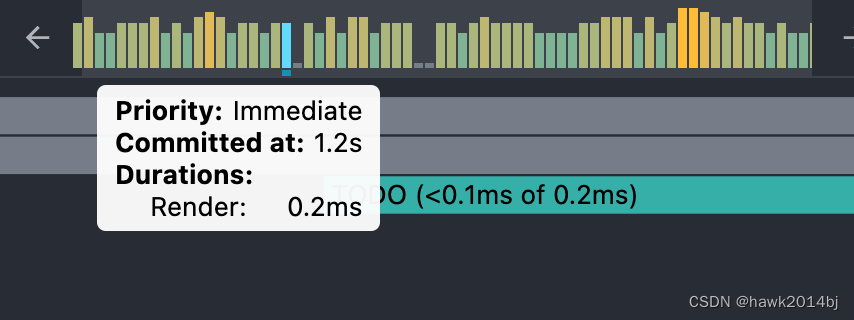为什么需要调度
在 React 中,组件最终体现为 Fiber,并形成 FiberTree,Fiber 的目的是提高渲染性能,将原先的 React 渲染任务拆分为多个小的微任务,这样做的目的是可以灵活的让出主线程,可以随时打断渲染,后面再继续执行。由于需要让出主线程,需要将任务保存起来,一个个排队执行,需要的时候进行切换,为了实现排队、切换,就需要实现一个调度引擎,哪个任务先执行,哪个任务后执行,暂停之后怎么继续执行。
优先级队列
React 中,Scheduler.js 定义了定义了调度的核心逻辑,Task 包存在一个 PriorityQueue 中,优先级高的任务会先进行处理。
WorkLoop
React 中,WorkLoop 是指循环Fiber Tree 去找需要处理的任务,WorkLoop 分为同步和并发,这两个逻辑几乎一样,并发处理是,要检查是否要暂停并释放主线程给浏览器执行其他任务。
## 同步,不能中断
function workLoopSync() {
while (workInProgress !== null) {
performUnitOfWork(workInProgress);
}
}
function workLoopConcurrent() {
while (workInProgress !== null && !shouldYield()) {
performUnitOfWork(workInProgress);
}
}
shouldYield 大于 5 毫秒就会释放,打开 React Tools Profile 可以看到这个渲染过程
function shouldYieldToHost() {
const timeElapsed = getCurrentTime() - startTime;
if (timeElapsed < frameInterval) {
// The main thread has only been blocked for a really short amount of time;
// smaller than a single frame. Don't yield yet.
return false;
}

调度
首先,调度创建任务,任务通过 callback function 创建,源码 Sheduler.js -> unstable_scheduleCallback,可以看到,优先级是通过过期时间进行定义的,越早过期的优先级越高,正常的任务 5 秒过期,USER_BLOCKING_PRIORITY_TIMEOUT 阻碍用户操作的任务 250 毫秒。
var timeout;
switch (priorityLevel) {
case ImmediatePriority:
timeout = IMMEDIATE_PRIORITY_TIMEOUT;
break;
case UserBlockingPriority:
timeout = USER_BLOCKING_PRIORITY_TIMEOUT;
break;
case IdlePriority:
timeout = IDLE_PRIORITY_TIMEOUT;
break;
case LowPriority:
timeout = LOW_PRIORITY_TIMEOUT;
break;
case NormalPriority:
default:
timeout = NORMAL_PRIORITY_TIMEOUT;
break;
}
var expirationTime = startTime + timeout;
var newTask = {
id: taskIdCounter++,
callback,
priorityLevel,
startTime,
expirationTime,
sortIndex: -1,
};
任务加入队列并执行
if (startTime > currentTime) {
// This is a delayed task.
newTask.sortIndex = startTime;
##########加入队列
push(timerQueue, newTask);
if (peek(taskQueue) === null && newTask === peek(timerQueue)) {
// All tasks are delayed, and this is the task with the earliest delay.
if (isHostTimeoutScheduled) {
// Cancel an existing timeout.
cancelHostTimeout();
} else {
isHostTimeoutScheduled = true;
}
// Schedule a timeout.
requestHostTimeout(handleTimeout, startTime - currentTime);
}
} else {
newTask.sortIndex = expirationTime;
##########加入队列
push(taskQueue, newTask);
if (enableProfiling) {
markTaskStart(newTask, currentTime);
newTask.isQueued = true;
}
// Schedule a host callback, if needed. If we're already performing work,
// wait until the next time we yield.
if (!isHostCallbackScheduled && !isPerformingWork) {
isHostCallbackScheduled = true;
requestHostCallback(flushWork);
}
requestHostCallback 最终会调用 schedulePerformWorkUntilDeadline,schedulePerformWorkUntilDeadline会调用 performWorkUntilDeadline。
### 调用 schedulePerformWorkUntilDeadline
function requestHostCallback(callback) {
scheduledHostCallback = callback;
if (!isMessageLoopRunning) {
isMessageLoopRunning = true;
schedulePerformWorkUntilDeadline();
}
}
## 最终调用 performWorkUntilDeadline
let schedulePerformWorkUntilDeadline;
if (typeof localSetImmediate === 'function') {
// Node.js and old IE.
// There's a few reasons for why we prefer setImmediate.
//
// Unlike MessageChannel, it doesn't prevent a Node.js process from exiting.
// (Even though this is a DOM fork of the Scheduler, you could get here
// with a mix of Node.js 15+, which has a MessageChannel, and jsdom.)
// https://github.com/facebook/react/issues/20756
//
// But also, it runs earlier which is the semantic we want.
// If other browsers ever implement it, it's better to use it.
// Although both of these would be inferior to native scheduling.
schedulePerformWorkUntilDeadline = () => {
localSetImmediate(performWorkUntilDeadline);
};
} else if (typeof MessageChannel !== 'undefined') {
// DOM and Worker environments.
// We prefer MessageChannel because of the 4ms setTimeout clamping.
const channel = new MessageChannel();
const port = channel.port2;
channel.port1.onmessage = performWorkUntilDeadline;
schedulePerformWorkUntilDeadline = () => {
port.postMessage(null);
};
} else {
// We should only fallback here in non-browser environments.
schedulePerformWorkUntilDeadline = () => {
localSetTimeout(performWorkUntilDeadline, 0);
};
}
scheduledHostCallback(hasTimeRemaining, currentTime) ,通过上面的代码的定义可知scheduledHostCallback 就是flushWork,所以这里是调用 flushWork(hasTimeRemaining, currentTime)
const performWorkUntilDeadline = () => {
if (scheduledHostCallback !== null) {
const currentTime = getCurrentTime();
// Keep track of the start time so we can measure how long the main thread
// has been blocked.
startTime = currentTime;
const hasTimeRemaining = true;
// If a scheduler task throws, exit the current browser task so the
// error can be observed.
//
// Intentionally not using a try-catch, since that makes some debugging
// techniques harder. Instead, if `scheduledHostCallback` errors, then
// `hasMoreWork` will remain true, and we'll continue the work loop.
let hasMoreWork = true;
try {
hasMoreWork = scheduledHostCallback(hasTimeRemaining, currentTime);
} finally {
if (hasMoreWork) {
// If there's more work, schedule the next message event at the end
// of the preceding one.
schedulePerformWorkUntilDeadline();
} else {
isMessageLoopRunning = false;
scheduledHostCallback = null;
}
}
} else {
isMessageLoopRunning = false;
}
// Yielding to the browser will give it a chance to paint, so we can
// reset this.
needsPaint = false;
};
flushWork 在调用 workLoop, workLoop 是 scheduler 核心
function flushWork(hasTimeRemaining, initialTime) {
// 省略一部分代码
isPerformingWork = true;
const previousPriorityLevel = currentPriorityLevel;
try {
if (enableProfiling) {
try {
return workLoop(hasTimeRemaining, initialTime);
workLoop 是 Scheduler 的核心方法,当 currentTask 的 callback 是一个方法,这部分处理暂停任务,如果callback返回一个 function,那么在一次执行中还是执行当前任务,否则任务完成。
const callback = currentTask.callback;
if (typeof callback === 'function') {
currentTask.callback = null;
currentPriorityLevel = currentTask.priorityLevel;
const didUserCallbackTimeout = currentTask.expirationTime <= currentTime;
if (enableProfiling) {
markTaskRun(currentTask, currentTime);
}
const continuationCallback = callback(didUserCallbackTimeout);
currentTime = getCurrentTime();
//**************是否是暂停任务
if (typeof continuationCallback === 'function') {
currentTask.callback = continuationCallback;
if (enableProfiling) {
markTaskYield(currentTask, currentTime);
}
} else {
if (enableProfiling) {
markTaskCompleted(currentTask, currentTime);
currentTask.isQueued = false;
}
if (currentTask === peek(taskQueue)) {
pop(taskQueue);
}
}
advanceTimers(currentTime);
} else {
pop(taskQueue);
}
总结
React 调度是用来调度 fiber 任务的,任务可以暂停并将控制权交给浏览器,调度的核心是通过 Priority Queue 实现,根据重要程度进行排序,过期时间作为排序字段,先到期的先执行。





















 100
100











 被折叠的 条评论
为什么被折叠?
被折叠的 条评论
为什么被折叠?








